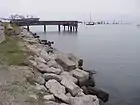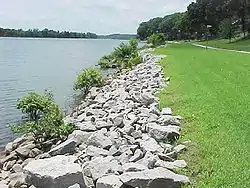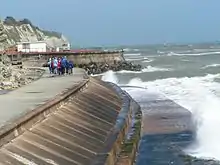Riprap
Riprap, also known as rip rap, rip-rap, shot rock, rock armor, or rubble, is human-placed rock or other material used to protect shoreline structures against scour and water, wave, or ice erosion.[1][2][3] Ripraps are used to armor shorelines, streambeds, bridge abutments, foundational infrastructure supports and other shoreline structures against erosion.[1][2][3] Common rock types used include granite and modular concrete blocks.[4][5] Rubble from building and paving demolition is sometimes used.[3][6]
| Look up riprap in Wiktionary, the free dictionary. |

Riprap is also used underwater to cap immersed tubes sunken on the seabed to be joined into an undersea tunnel.
Environmental Consequences
Sediment effects
Ripraps cause morphological changes in the riverbeds they surround. One such change is the reduction of sediment settlement in the river channel, which can lead to scouring of the river bed as well as coarser sediment particles. Ripraps have also been shown to cause erosion of sites downstream of the riprap.[7]
Changes in organic material
The addition of ripraps often leads to reduced plant cover, woody material and other organic material, which can result in environmental changes such as reduced shading. Introducing ripraps, however, does produce a more rocky environment, which increases heterogeneity, creating additional niches for some organism.[8] The reduction in shading along with the introduction of new niches that result from implementation of ripraps improves survivability of certain species that have an affinity for these conditions. Yet these conditions present adverse circumstances and decreased habitability for species not accustom to this environment.[7][8]
Gallery
 Concrete rubble used as riprap along the San Francisco Bay shoreline
Concrete rubble used as riprap along the San Francisco Bay shoreline Modular concrete block riprap
Modular concrete block riprap Modular concrete block riprap
Modular concrete block riprap Modular concrete block riprap
Modular concrete block riprap Riprap lining a lake shore
Riprap lining a lake shore.jpg.webp) Riprap closing off a channel on the Mississippi River
Riprap closing off a channel on the Mississippi River.jpg.webp) Riprap protecting a levee
Riprap protecting a levee Crews replacing riprap at Galveston Seawall after a 1915 hurricane
Crews replacing riprap at Galveston Seawall after a 1915 hurricane
See also
References
- Trmal, Céline; Dupray, Sébastien; Heineke, Daan; McConnell, Kirsty (2009). "USING ROCK IN HYDRAULIC ENGINEERING – NEW GUIDANCE AN UPDATED VERSION OF THE MANUAL ON THE USE OF ROCK IN HYDRAULIC ENGINEERING". Coastal Structures 2007. Venice, Italy: World Scientific Publishing Company: 220–224. doi:10.1142/9789814282024_0020. ISBN 978-981-4280-99-0.
- Breakwaters, coastal structures and coastlines : proceedings of the international conference organized by the Institution of Civil Engineers and held in London, UK on 26-28 September 2001. Allsop, N. W. H., Institution of Civil Engineers (Great Britain). London: T. Telford. 2002. ISBN 0-7277-3042-8. OCLC 51483089.CS1 maint: others (link)
- "What is Riprap | Muse Hauling & Grading". www.musehg.com. Retrieved 2020-12-07.
- Aguilera, Moisés A.; Arias, René M.; Manzur, Tatiana (2019). "Mapping microhabitat thermal patterns in artificial breakwaters: Alteration of intertidal biodiversity by higher rock temperature". Ecology and Evolution. 9 (22): 12915–12927. doi:10.1002/ece3.5776. ISSN 2045-7758. PMC 6875675. PMID 31788225.
- "Erosion Control Blankets vs. Rip Rap | East Coast Erosion". East Coast Erosion Control. 2020-05-22. Retrieved 2020-12-06.
- "Welcome to ROSA P |". rosap.ntl.bts.gov. Retrieved 2020-12-06.
- Reid, David; Church, Michael (2015). "Geomorphic and Ecological Consequences of Riprap Placement in River Systems". JAWRA Journal of the American Water Resources Association. 51 (4): 1043–1059. doi:10.1111/jawr.12279.
- Chhor, Auston D.; Glassman, Daniel M.; Smol, John P.; Vermaire, Jesse C.; Cooke, Steven J. (2020). "Ecological consequences of shoreline armoring on littoral fish and benthic macroinvertebrate communities in an Eastern Ontario lake". Aquatic Sciences. 82 (4): 73. doi:10.1007/s00027-020-00740-0. ISSN 1015-1621.
- Ciria-CUR (2007) - Rock Manual - The use of rock in hydraulic engineering.
- N.W.H. Allsop (2002) - Breakwaters, coastal structures and coastlines.
- US Dept. of Transportation (2004) - Trail Construction and Maintenance Notebook
